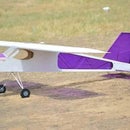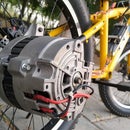Introduction: DIY Powerful Induction Heater
Induction heaters are definitely one of the most efficient way of heating metal objects specially ferrous metals. The best part about this induction heater is that you dont need to have a physical contact with the object to be heated.
There are a lot of induction heater kits available online but if you want to learn the basics of induction heating and want to built one that looks and performs exactly like a high end one then keep going through this instructable as I will show you how an induction heater works and where you can source your material to built one for yourself that looks like a professional one.
Lets get started...
Step 1: Concept Behind Induction Heating
There are multiple methods of heating metals, one of which is induction heating. As the name of the method refers the heat is generated within the material by using electrical induction.
Electrical induction takes place within the material as the magnetic field around it changes continuously that results in the induction of eddy currents within the material that is placed inside the coil. Thus causing instant heating and the effect is most prominent in ferrous metals due to its higher response to magnetic forces.
You can get more in-depth overview on wikipedia :
Step 2: Printed Circuit Board and Components
Since I am going to use a battery/ power supply that gives us an output of 12v DC that is not sufficient enough to produce induction as the magnetic field produced in the induction coil due to Direct Current is a Constant Magnetic Field. So the task here is to convert this DC voltage into Alternating Current which will thus produce induction.
So I have designed an Oscillator circuit which produces AC output having square wave of nearly 20 KHz frequency. The circuit uses four IRF540 N-Channel mosfets to frequently switch the current in alternating direction. To safely handle larger amount of currents I have used a pair of mosfets in each channel.
Since we are going to deal with higher amount of currents thus a perfboard is definitely not a reliable and of course not a neat option. So I decided to go with a much reliable option that is a printed circuit board. That might sound like an expensive option but with that thought in mind I came across JLCPCB.com
These guys are offering high quality PCB at outstanding prices. I have ordered 10 PCBs for the induction heater and as the first order these guys are offering all that in just 2$ including the shipment cost at door step.
The quality is premium as you can see in the pictures. So be sure to check out their website.
Step 3: Ordering PCB
The process to order PCB is quiet simple. First you have to visit jlcpcb.com. To get an instant quote all you need to do is to upload your Gerber file for the PCBs and one they are done uploading you can go through the option given below.
I have also added thee Gerber file for the PCB in this step so be sure to check it out.
Attachments
Step 4: Complementary Parts
I have started to assemble PCB with small complementary parts which includes resistors and a couple of diodes.
R1,R2 are 10k resistors. R3 and R4 are 220Ohm resistors.
D1 and D2 are UF4007 diodes (UF stands for Ultra Fast), don't replace them with 1N4007 diodes as they will blow up. D3 and D4 are zener diodes 1N821.
Make sure you place the right component at right place and also place the diodes in the right direction as shown on the PCB.
Step 5: MOSFETs
In order to handle large amount of current drains I decided to go with N-Channel MOSFETs. I have used a pair of IRF540N MOSFET on each side. Each of them is ratted at 100 Vds and upto 33Amperes of continuous current drain. Since we are going to power this induction heater with 15VDC, 100 Vds might sounds an over kill, but actually its not as the spikes generated during high speed switching can easily jump upto those limits. So better to go with even higher Vds ratting.
To dissipate excess heat I have attached aluminium heat sinks to each one of them.
Step 6: Capacitors
The capacitors plays an important role to maintain a desirable output frequency , which in case of induction heating is suggested at nearly 20KHz. This output frequency is a result of the combination of induction and capacitance. So you can use an LC frequency calculator to calculate your desirable combination.
Its good to have more capacitance but always keep in mind that we have to get the output frequency somewhere near 20KHz.
So I decided to go with WIMA MKS 400VAC 0.33uf non-polar capacitors. Actually I was unable to find higher voltage ratting for these capacitors so latter they swelled up and I had to replace them with some other non polar capacitors that are ratted at 800VAC.
There are two of them connected in parallel.
Step 7: Inductors
Since its hard to find high current inductors so I decided to built it by myy self. I have got some old ferrite core from old computer scrap with the following dimensions:
Outer dia: 30mm
Inner dia: 18mm
Width: 13mm
Its not necessary to get an exact size ferrite core but the goal here is to get a pair of inductors that can provide an inductance of nearly 100 Micro Henry. For that I have used 1.2mm insulated copper wire to wind the coils such that each of them has 30 turns. This configuration is subjected to produce the required inductance. Make sure you do the windings as tight as possible since its not recomended to have more gap between the core and the wire.
After winding the inductors, I have removed the insulated coatings from both ends of wire so that they are ready to get soldered on to the PCB.
Step 8: Cooling Fan
In order to decipate the heat from the MOSFETs, I have mounted a 12v PC fan just above the aluminium heat sinks using some hot glue. The fan is then connected to the input terminals so that whenever you power the induction heater the fans will automatically power up to cool down the MOSFETs.
Since I am going to power this induction heater using a 15VDC supply so I have added a 10 OHM 2watts resistor to drop the voltage down to the safe limit.
Step 9: Connectors for Output Coil
To connect the output coil to the induction heating circuit I have made a pair of hatches onto the PCB using an angle grinder. Latter I have broken down an XT60 Connector to use its pins for the output terminals. Each of these pins push fit inside the output copper coil.
Step 10: Induction Coil
The Induction coil is made using a 5mm diameter copper pipe that is commonly used in air conditioners and refrigerators. To wind the output coil perfectly I have used a cardboard roll measuring nearly an inch in diameter. I have given 8 turns to the coil which created a width of coil to fit exactly onto the output bullet connectors.
Make sure to wind the coil patiently as you might end up bending the pipe causing a dent in it. Moreover after you are done winding the coil make sure that there is no contact between the walls of two consecutive turns.
For this coil you need 3 foots of copper pipe.
Step 11: Power Supply
To power this induction heater I am going to use a server power supply that is ratted for 15v and can deliver upto 130 Amps of current. But you can use any 12v source such as a car battery or a PC power supply.
Make sure to connect the input with right polarity.
Step 12: Final Results
As I powered this induction heater at 15v, it beings to draw nearly 0.5 Amp current without anything placed inside the coil. For the test run I have inserted a wooden screw and suddenly it starts to smell like its getting heated. The current draw also starts to increase and with the screw fully inserted the coil it seems to draw nearly 3 amps of current. Within just a minute it gets red hot.
Later I have inserted a screw driver inside the coil and the induction heater heated it to red hot with nearly 5 amperes of current draw at 15v which sums up to 75 watts of induction heating.
Overall the induction heating seems to be a good way of efficiently heating a ferrous metal rod and it is less dangerous as compared to other methods.
There are alot of useful things that can be done using this method of heating.
If you like this project then don't forget to visit and subscribe to my youtube channel for more upcoming projects.
https://www.youtube.com/channel/UCC4584D31N9RuQ-aE...
Regards.
DIY King






